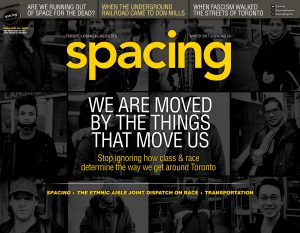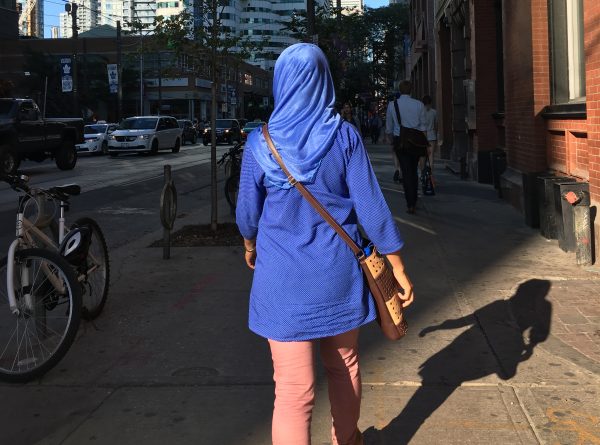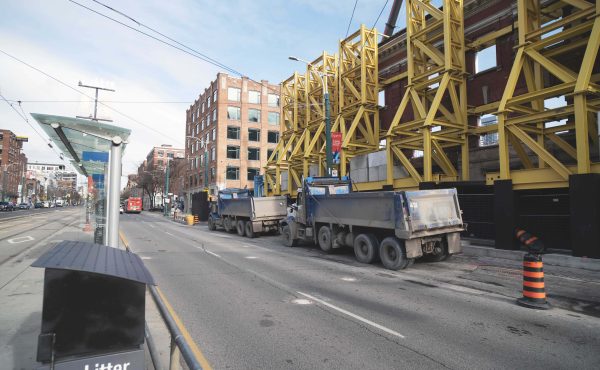In December 2015, I was scheduled to speak at the Toronto Dawah Centre in the Bloor Dufferin neighbourhood. Various faith communities were gathering there in solidarity to respond to a recent spate of Islamophobic attacks in Toronto. I was going to speak about the overwhelming support I received from friends and supporters; I was going to share how, in these hard times, Torontonians of various backgrounds had come forward to stand with me. However, although I am a dedicated TTC user, I had decided to take a cab there instead of the bus because I was afraid for my safety.
The federal Conservative Party’s use of racist and Islamophobic rhetoric during the 2015 election — such as the proposed “Zero Tolerance for Barbaric Cultural Practices Act” and an RCMP tip line for people to report “incidents of barbaric cultural practices in Canada” — had normalized anti-Muslim sentiments across the country. Islamophobic graffiti was found on the walls of a subway station, and two female Muslim students were verbally assaulted at another station. Most alarmingly, a Muslim mother was brutally beaten in broad daylight near her childrens’ school.
I immediately felt like a target. I felt unsafe. The victims were women who wore the hijab just like me.
As a precaution, I imposed restrictions on myself: to be aware of my surroundings and not to wear headphones while travelling. I decided not to be out late by myself, and if that was unavoidable, to take a cab — never the TTC.
Gendered barriers in accessing Toronto’s transit system are a long-standing issue. To begin with, there is a gap in the system’s design that puts women at a disadvantage: for example, women reportedly use the TTC for multiple short trips, whereas the system is designed for singular long trips. The commission’s 2014 Annual Report on Diversity and Human Rights Achievements found that over half of all TTC riders are women, even though they make up only 15% of the TTC’s workforce. Most alarmingly, a more recent report released in October 2016 showed that one in three women riders have been assaulted while riding the TTC.
The issue of gender inequity in accessing the city’s public transit is substantially exacerbated for Muslim women, since anti-Muslim sentiments rise in tandem with Islamophobic attacks on visibly Muslim women. I don’t know if my precautionary measures were what kept me from getting harassed or attacked. I do know that other Muslim women were not as lucky.
“This is literally my only means of transportation on a daily basis because I do not have my own car and I do live 30 kilometres away from campus,” says Mariam Nouser, a student at Ryerson University and the president of the school’s Muslim Students Association. She has experienced multiple incidents of verbal and physical assault in Toronto (growing up as a Muslim, she has had many incidents dating way back).
Two of them happened on a subway car. In 2014, a female passenger repeatedly yelled, “Go home!” at Nouser, spitting on her and tugging at her hijab. Luckily the subway car reached a stop and Nouser was able to quickly exit. Another time, when she was travelling with several Muslim male friends with brown skin and beards, Nouser says she and her friends were called “terrorists” by a random man.
Although other passengers quickly intervened to confront the man and reassure the students, Nouser says that, like me, she’s left feeling helpless and vulnerable by these incidents, robbed of her sense of safety. “It makes me more diligent in looking around and, of course, I’m not as comfortable as I was to go out alone,” she says.
“I don’t know if my precautionary measures
were what kept me from getting harassed or attacked.
I do know that other Muslim women were not as lucky.”
This self-elimination from public spaces can have devastating emotional and social consequences. Hawa Y. Mire is a Toronto-based Somali storyteller and strategist who says that she increasingly hears about Muslim women who skip the TTC altogether, even when they don’t own their own cars. “More and more Muslim women I know won’t go to places unless they have a ride,” she says. “Young women are less likely to travel by themselves. They leave spaces that they are entitled to have access to.”
Mire notes that the intersection of skin colour, gender, and religion compound the issue of safety for women who are both Black and visibly Muslim. “Black women already encounter regular surveillance and with the added addition of Muslimah ‘attire’ there is a sharp increase in the permissibility of the violence allowed to occur” she says, adding that in her own experience, harassment is more likely when she is in the company of friends who wear the hijab.
Blatantly racist and Islamophobic attacks — such as in New York City, where a woman wearing a hijab was recently pushed down a flight of subway stairs — are the most frightening, but Mire says that subtler forms of bigotry also negatively impact the sense of security for Muslim women, particularly if they are Black.
Consequently, when Muslim women aren’t able to travel on the TTC safely, all other activities that rely on safe transit are curtailed. “What happens to your ability to imagine yourself into powerful positions?” Mire asks. “What happens to your ability to access services?”
Many countries — including India and Egypt — have women-only trains and subway cars to reduce sexual harassment and assault, and I thought this might be a solution for Toronto’s Muslim women. But when I suggested it to Roger Keil, professor at York University’s Faculty of Environmental Studies, he disagreed. “We don’t want the state to tell me or you what car to ride in,” he says.
“I actually would hate to live in a society where we accept that we have to put Muslim women into a separate subway car,” says Keil. “I think it’s more important that we make all public spaces accessible, safe for everyone who is under that kind of threat.”
For him, the solution lies in educating the public on how to intervene during instances of Islamophobia, as well as other forms of bigotry.
“We need to have a very aggressive campaign to bring this to public consciousness,” Keil says, “where people understand that this is an issue and that there are those people who are more in danger — not just Muslim women but those people who are more in danger of being attacked in public spaces.”
Keil would like to see open town halls where riders can share their experiences of harassment, and also learn how to help and support each other.
Habon Ali, an urban planner who is also a visible Muslim woman, feels that technology can further galvanize public support. Ali says, “we’re hearing more about people designing tailored apps to support more safety and to increase efficiency in the transit system.” As an example, the Facebook group BuddyUpTO helped me find a “travel buddy” when I was feeling especially vulnerable during the 2015 federal election.
With Donald Trump’s victory in the recent US election, there’s been another spike in racist and xenophobic attacks on Muslims and other people of colour, both in the States and Canada. In fact, just one week later, a brown-skinned man was verbally assaulted and told to “go back to your f*****g country” on a 512 St. Clair streetcar.
But as Keil might hope, bystanders quickly intervened, directly confronting the attacker and later forcing him off the streetcar. The incident was recorded on a cellphone and the video quickly became viral, prompting immediate media attention and public outcry.
Perhaps this is evidence that public attitudes can be shifted to better respond to Islamophobic incidents towards Muslim women. At times when they are most vulnerable, the public has the potential and the collective responsibility to ensure that these women retain their right to access public spaces in safety.
photo by Charles Yao
 This story originally appeared in Spacing’s winter 2017 issue.
This story originally appeared in Spacing’s winter 2017 issue.





One comment
The first step towards change is admitting there is a problem. We need more talk like this.
I find that when I talk about racism in Canada, most Canadians are offended. Claiming that Canadians are not like Americans, we don’t have racism here.
I have a very annoying conversation with a middle-aged White man a few years ago. He just randomly talked to me at the store after reading a headline on violence against US Muslims. Then he said, “Sure feels great to be Canadians.” I then said it happens here too. (That was weeks after the incident where the Muslim lady was beaten near her kids’ school.) He then accused me of, “not from here” (I’m Asian). Then ask me what my “nationality” was. He wasn’t being mean, but he gave me this impression that he is very ignorant. He’s in this Canadians-are-all-nice-and-polite bubble.
We need to burst this bubble. People need to know that the problem exists.
While violence is intolerable. I find that most people turn a blind eye on milder microaggressions. Like not serving certain ethnic groups. Well, they don’t really not serve them. What they do is to help other customers first, make them wait, leaving them frustrated so they leave. This is the kind of racism we have here.